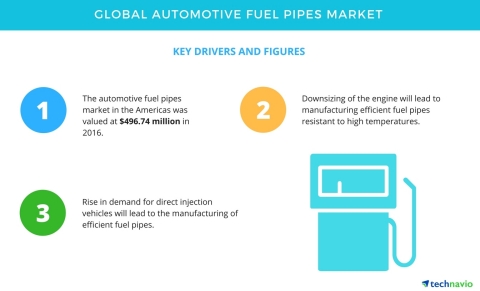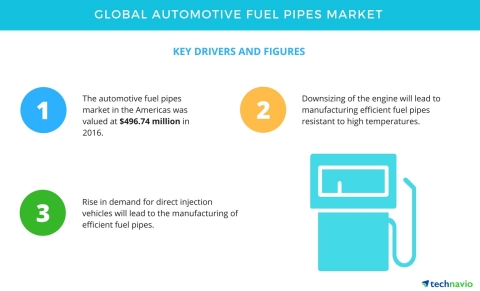LONDON--(BUSINESS WIRE)--The latest market research report by Technavio on the global automotive fuel pipes market predicts a CAGR of around 7% during the period 2017-2021.
The report segments the global automotive fuel pipes market by application (passenger car, light commercial vehicle, and medium and heavy commercial vehicle), and by geography (the Americas, EMEA, and APAC). It also provides a detailed illustration of the major factors influencing the market, including drivers, opportunities, trends, and industry-specific challenges.
Here are some key findings of the global automotive fuel pipes market, according to Technavio automotive researchers:
- Increasing focus on reducing the curb weight of the vehicle: a major market driver
- In 2016, the passenger car segment dominated the market with a share of around 72%
- APAC accounted for the largest market share of in 2016, followed by EMEA and the Americas
- Continental, Gates Corporation, Magna International, and Sumitomo Riko are the leading players in the market
This report is available at a USD 1,000 discount for a limited time only: View market snapshot before purchasing
Buy 1 Technavio report and get the second for 50% off. Buy 2 Technavio reports and get the third for free.
Market growth analysis
Increasing focus on reducing the curb weight of the vehicle is one of the major factors driving the global automotive fuel pipes market. The automotive industry is keen on reducing the weight of the vehicles, as it will improve the agility, driving dynamics, and fuel consumption. The global trends where government across all the region have been focusing toward the reduction of carbon emission and enhancing the fuel economy benefits have led the OEMs to focus on different measures to reduce the weight of the vehicle. As a result, fuel pipes manufacturers are using carbon fiber reinforced plastics to reduce the weight of the vehicle.
According to Raj Gaurav Singh, a lead analyst at Technavio for research on automotive components, “The use of carbon fiber is growing even in the fuel line assembly to reduce the weight of the vehicle. Although carbon fiber is approximately 5-6 times costlier than the steel, improved technologies and economies of scale will help to reduce the cost of carbon fiber by 2021 significantly. Therefore, automotive fuel pipes made of high-performance plastics and reinforced carbon fiber will be in demand during the forecast period.”
Looking for more information on this market? Request a free sample report
Technavio’s sample reports are free of charge and contain multiple sections of the report including the market size and forecast, drivers, challenges, trends, and more.
Geographical analysis
Technavio researchers anticipate high growth for the global automotive fuel pipes market in China, India, and Japan, which are the main markets in APAC. These countries account for most of the demand for automotive fuel pipes. The per-capita income in the region has increased significantly over the past couple of years with rapid economic growth in the region, thereby increasing the purchasing power of the consumers and leading to higher automobile sales.
The factors driving the growth of the automotive fuel pipes market are stringent emission norms, growing focus on enhancing the fuel efficiency, and increased trend of downsizing of the engine. The evolving market for the direct injection technology and the growing focus on downsizing the engine have led to innovations in the automotive fuel pipes market. Automotive fuel pipes are designed to withstand higher temperature and pressure.
Competitive vendor landscape
The global automotive fuel pipes market is highly competitive due to the presence of many suppliers operating in the market. The competitive environment in the market will further intensify with advances in technology, stringent emission norms, and growing focus of OEMs on reducing the weight of the vehicle.
The global players dominate the global automotive fuel pipes market due to the mass production facilities (economies of scale), direct relationships with OEMs, quality of the products they produce, and their established distribution channels. Local players, on the other hand, can maintain their market position due to a better understanding of their local markets and strong distribution network in the aftermarket segment.
Get a sample copy of the global automotive fuel pipes market report free of cost
Access Technavio’s continuously growing automotive components, research library and find expert analysis on hundreds of markets.
About Technavio
Technavio is a leading global technology research and advisory company. Their research and analysis focuses on emerging market trends and provides actionable insights to help businesses identify market opportunities and develop effective strategies to optimize their market positions.
With over 500 specialized analysts, Technavio’s report library consists of more than 10,000 reports and counting, covering 800 technologies, spanning across 50 countries. Their client base consists of enterprises of all sizes, including more than 100 Fortune 500 companies. This growing client base relies on Technavio’s comprehensive coverage, extensive research, and actionable market insights to identify opportunities in existing and potential markets and assess their competitive positions within changing market scenarios.
If you are interested in more information, please contact our media team at media@technavio.com.




